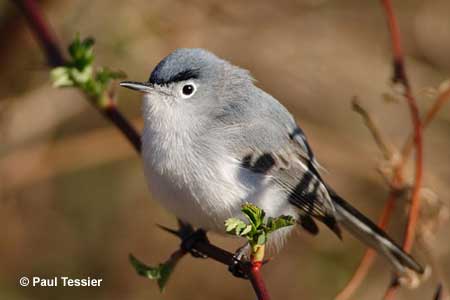Have you ever seen the Blue-Gray Gnatcatcher before? These birds are not as known as some other birds but they’re actually very interesting. For example, did you know that Blue-Gray Gnatcatchers are monogamous, meaning they mate for life.
These birds are very widespread but not plentiful. They breed from southern Canada to North America, Cuba, and Guatemala. They winter from the Atlantic coast to southern South Carolina, along southern Texas, Mississippi, and South and Central America.
On this page
Breeding Male
Breeding male Blue-Gray Gnatcatchers are tiny birds with slim, long legs. They have long tails and straight, narrow bills. The blue-gray color can be seen above on the head and back, and white can be seen below on the abdomen.
One distinct feature that breeding males have are a black V-shape on the forehead that extends above their eyes. Note the black tail, light outer tail feathers, and eyering.
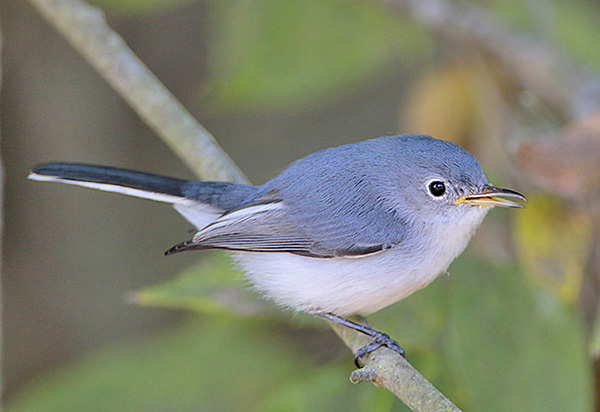
Photograph © Greg Lavaty.
Female
Female and non-breeding male Blue-Gray Gnatcatchers look relatively similar to breeding males. These birds are tiny, slim, and have straight, narrow bills.
However, instead of having the blue-gray color on the head and back, the females and non-breeding males have gray on the head and back with a skinny white eyering.
Juvenile
Juvenile Blue-Gray Gnatcatchers closely resemble females. They’re tiny, slim, and have straight, narrow bills. However, instead of having the blue-gray color on the head and back, they have gray on the head and back with a skinny white eyering. Their wings are also slightly browner than females.
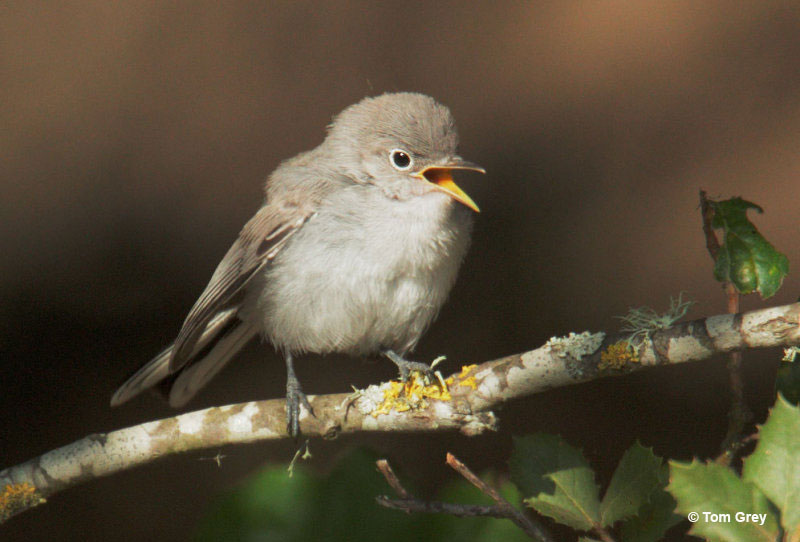
© Tom Grey
Habitat
The Blue-Gray Gnatcatcher is found in scrublands and broadleaf forests. A breeding pair’s male and female will choose where they will build the nest for the year. The nest is usually made in broadleaf trees like oaks or maples. Nests are built on side limbs well towards the end and often sit around a twig or knot or against a side branch for support.
Both parents will build the nest as well. It’ll take up to two weeks to finish the two to three-inch wide nest. Nests are attached to a branch, held together with spiderwebs, and decorated with lichen.
The main structural layer of the nest is built with fibrous materials like bark strips, grasses, and plant stems. These materials are held together with caterpillar silk or spiderwebs.
Diet
Blue-Gray Gnatcatchers mostly eat small insects. The insects they consume vary by region; in the southwest, some of them include treehoppers, leafhoppers, plant bugs, caterpillars, leaf beetles, tiny wasps, flies, and spiders.
In the Northwest, it’s common for Blue-Gray Gnatcatchers to consume both larval and adult moths. In fact, moths can provide up to half the prey they consume in the region. Blue-Gray Gnatcatchers swallow smaller prey alive, while larger prey has its wings torn off (if they have any), and the bodies are beaten against a perch before being eaten.
Parents usually feed the juveniles these foods, and they’re sure to offer larger and larger prey as the chicks mature.
Behavior
The Blue-Gray Gnatcatcher is definitely a busier forager in comparison to other birds. They move swiftly through dense foliage, slide and hop along branches, and move their heads quickly to easily find small spiders and insects. They scare insects and spiders out of their hiding spot by flashing the white parts of their long tail.
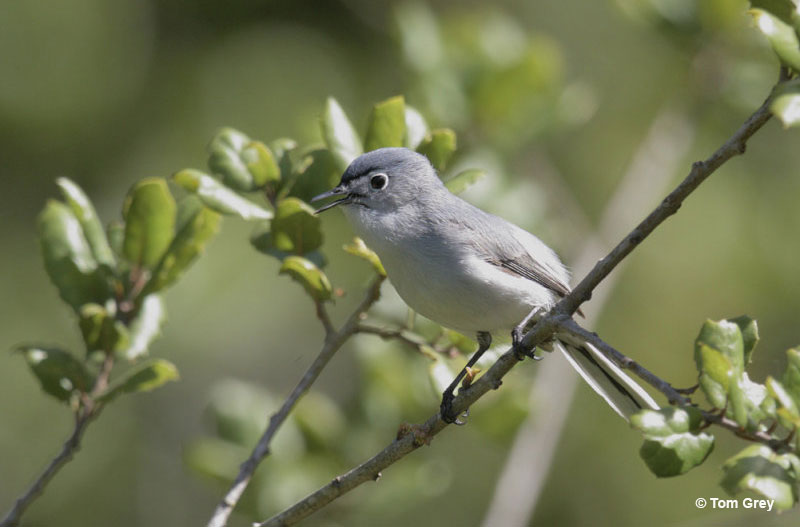
© Tom Grey
These gnatcatchers will aggressively defend their territories. They’re even known to attack birds that are much larger than them; adults will even mob possible predators with other small birds.
The male and female pair often cooperate in challenging an intruder. However, the female’s aggressive calls and the male’s soft territorial songs can quickly turn into an extended chase. Aggression can become elevated with bill snapping, soaring aerial confrontation, and even lengthy grappling on the ground.
Range (and seasonal changes)
These birds breed from southern Canada to North America, Cuba, and Guatemala. They winter from the Atlantic coast to southern South Carolina, along southern Texas, Mississippi, and South and Central America.
The Blue-Gray Gnatcatcher does have regional differences. Gnatcatchers from the Rocky Mountains and westward are duller than Gnatcatchers found in the east.
Western female Blue-Gray Gnatcatchers have a brownish gleam to their upperparts, and breeding males have a broader, shorter forehead V-shape. They also show black at the base of the tail underneath, unlike the eastern birds’ who have an entirely white tail on the underside.
Fun Facts
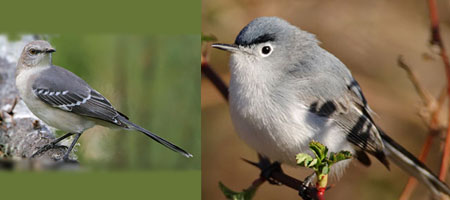
The Northern Mockingbird (left) in the image above is 10 in. long, the Blue-gray Gnatcatcher is 4.5 in. long. The mockingbird is just further away from the camera.
- The Blue-Gray Gnatcatcher’s long tail and grayish coloring, songs, and the way it mixes other birds’ sounds into its own earned it the nickname “Little Mockingbird.”
- A mating pair of Blue-Gray Gnatcatchers can build up to seven nests in one breeding season. It’s not uncommon for them to reuse nesting material from old nests. This is crucial because it speeds up the process of re-nesting, which is essential for breeding success. Predation, mite infestations, and nest parasitism frequently cause brood failure and nest loss.
- The oldest known Blue-Gray Gnatcatcher lived at least four years and two months old. It was a male, recaught at a banding station in the state of Pennsylvania and rereleased.
- Despite their name, gnats are not a significant part of the Blue-Gray Gnatcatcher’s diet.
- The Blue-Gray Gnatcatcher is the only truly migratory species of Gnatcatcher and the northernmost species. Most members of its genus take residence in South and Central America.
Vocalization
Male Blue-Gray Gnatcatchers have two types of songs. The first one is a more straightforward sequence of four to eight soft, short phrases. This type is usually sung once nesting has begun, not long after nesting season beings, in territorial disputes, and not long after sunrise. However, it can sometimes be heard on wintering grounds as well.
The more complex vocalizations are sung around early morning and midday. Some people suggest that Blue-Gray Gnatcatchers ‘Spee. Spee.” while others say, they sing “Steve.”
Both males and females use nasal calls that are high-pitched. A sharp, mewing chay or zeee contact call is let out in bursts of two to six notes about one second apart. A two-note bee-beee version of the call stated previously, where the first note slurrs downward, shows mild agitation.
Intense agitation causes high-pitched trills. A louder, sharper, and faster version of the contact call is used in aggressive encounters. Mobbing calls are similar to intense agitation calls but sound more urgent.
Similar Species
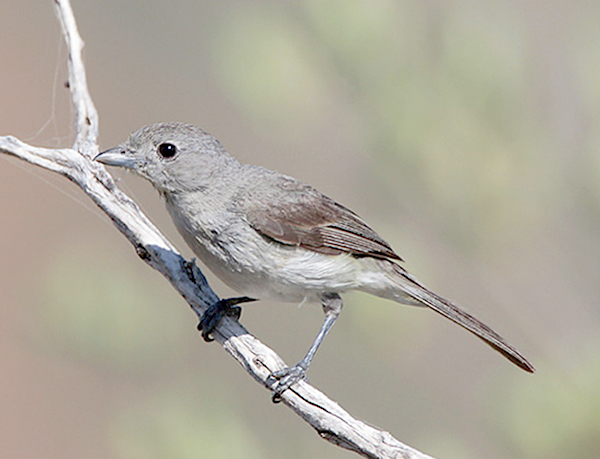
Gray Vireo
Although Gray Viros and Blue-Gray Gnatcatchers look similar, there are still a few differences. To start things off, Gray Vireos are bigger in size and have grayish plumage. Apart from that, they also have a thicker bill.
Gray Viros can be found in Mexico and southern parts of the United States, while Blue-Gray Gnatcatchers are widespread across the U.S.
Gray Viros prefer to live near shrubs.
Frequently Asked Questions
Are Blue-Gray Gnatcatchers rare?
Blue-Gray Gnatcatchers are not rare. However, they are uncommon. These birds have a wide range but are limited in terms of numbers.
Where do Blue-Gray Gnatcatchers live?
Blue-Gray Gnatcatchers live in scrublands and broadleaf forests. These birds breed from southern Canada to North America, Cuba, and Guatemala. They winter from the Atlantic coast to southern South Carolina, along southern Texas, Mississippi, and South and Central America.

